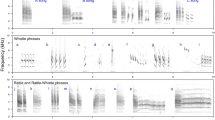Summary
During courtship, male red-winged blackbirds (Agelaius phoeniceus) produce long sequences of simple, single-note precopulatory calls, punctuated with occasional songs. Male song has previously been shown to stimulate copulation solicitation in captive, estradiol-implanted females of this species (Searcy and Brenowitz 1988; Searcy, in press). Here I show that sequences of precopulatory calls also stimulate copulation solicitation in female redwings, but that they are not as stimulatory as song. In tests contrasting mixed bouts of song and precopulatory calls with bouts of song alone, the mixed bouts elicited significantly more female solicitation in one instance, more but not significantly more in a second, and an exactly equal amount as song alone in a third. Neither song nor precopulatory calls could be shown to affect proximity of females to the speaker.
Similar content being viewed by others
References
Baker MC, Baker AEM (1988) Vocal and visual stimuli enabling copulation behavior in female buntings. Behav Ecol Sociobiol 23:105–108
Baker MC, Spitler-Nabors KJ, Bradley DC (1981) Early experience determines song dialect responsiveness of female sparrows. Science 214:819–820
Baker MC, Bjerke TK, Lampe H, Espmark Y (1986) Sexual response of female great tits to variation in size of males' song repertoires. Am Nat 128:491–498
Beletsky LD, Chao S, Smith DG (1980) An investigation of song-based species recognition in the red-winged blackbird (Agelaius phoeniceus). Behaviour 73:189–203
Brenowitz EA (1982) Long range communication of species identity by song in the red-winged blackbird. Behav Ecol Sociobiol 10:29–38
Brenowitz EA (1983) The contribution of temporal song cues to species recognition in the red-winged blackbird. Anim Behav 31:1116–1127
Catchpole CK, Dittami J, Leisler B (1984) Differential responses to male song repertoires in female songbirds implanted with oestradiol. Nature 312:563–564
Catchpole CK, Leisler B, Dittami J (1986) Sexual differences in the responses of captive great reed warblers (Acrocephalus arundinaceus) to variation in song structure and repertoire size. Ethology 73:69–77
King AP, West MJ (1977) Species identification in the North American cowbird: appropriate responses to abnormal song. Science 195:1002–1004
Miller DB (1979a) The acoustic basis of mate recognition by female zebra finches (Taenipygia guttata). Anim Behav 27:376–380
Miller DB (1979b) Long-term recognition of father's song by female zebra finches. Nature 280:389–391
Nero RW (1956) A behavior study of the red-winged blackbird. II. Territoriality. Wilson Bull 68:129–150
Nero RW (1984) Redwings. Smithsonian Institution Press, Washington
Orians GH, Christman GM (1968) A comparative study of the behavior of red-winged, tricolored, and yellow-headed blackbirds. Univ Calif Publ Zool 84:1–81
Searcy WA (1986) Are female red-winged blackbirds territorial? Anim Behav 34:1381–1391
Searcy WA (1989) Dual intersexual and intrasexual functions of song in red-winged blackbirds. Proc XIX Congr Intern Ornithol (in press)
Searcy WA, Andersson M (1986) Sexual selection and the evolution of song. Ann Rev Ecol Syst 17:507–533
Searcy WA, Brenowitz EA (1988) Sexual differences in species recognition of avian song. Nature 332:152–154
Searcy WA, Marler P (1981) A test for responsiness to song structure and programming in female sparrows. Science 213:926–928
Searcy WA, Marler P (1984) Interspecific differences in the response of female birds to song repertoires. Z Tierpsychol 66:128–142
Searcy WA, Searcy MH, Marler P (1982) The response of swamp sparrows to acoustically distinct song types. Behaviour 80:70–83
Tinbergen N (1954) The origin and evolution of courtship and threat display. In: Hyxley JS, Hardy AC, Ford EB (eds) Evolution as a process. Allen & Unwin, London, pp 233–250
Tinbergen N (1959) Comparative studies of the behaviour of gulls (Laridae): a progress report. Behaviour 15:1–70
Weatherhead PJ, Robertson RJ (1977) Male behavior and female recruitment in the redwinged blackbird. Wilson Bull 89:583–592
Wiley RH (1976) Communication and spatial relationships in a colony of common grackles. Anim Behav 24:570–584
Yasukawa K (1981a) Song repertoires in the red-winged blackbird (Agelaius phoeniceus): A test of the Beau Geste hypothesis. Anim Behav 29:114–125
Yasukawa K (1981b) Song and territory defense in the red-winged blackbird. Auk 98:185–187
Author information
Authors and Affiliations
Rights and permissions
About this article
Cite this article
Searcy, W.A. Function of male courtship vocalizations in red-winged blackbirds. Behav Ecol Sociobiol 24, 325–331 (1989). https://doi.org/10.1007/BF00290909
Received:
Accepted:
Issue Date:
DOI: https://doi.org/10.1007/BF00290909




